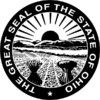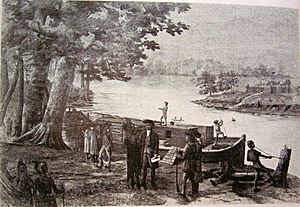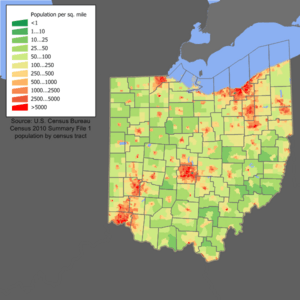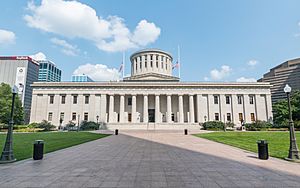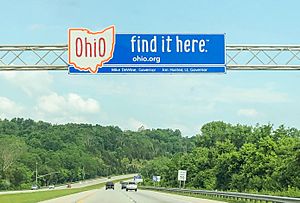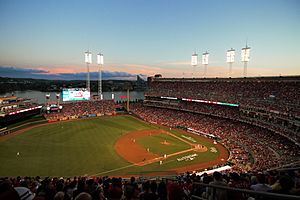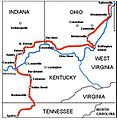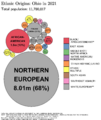Ohio facts for kids
Quick facts for kids
Ohio
|
|||
|---|---|---|---|
|
|||
| Nicknames:
The Buckeye State;
Birthplace of Aviation; The Heart of It All |
|||
| Motto(s): | |||
| Anthem: "Beautiful Ohio" |
|||
| Country | United States | ||
| Admitted to the Union | March 1, 1803 (17th, declared retroactively on August 7, 1953) |
||
| Capital (and largest city) |
Columbus | ||
| Largest metro and urban areas | Greater Cleveland (combined and urban) Cincinnati (metro) Columbus (metro) (see footnotes) |
||
| Legislature | General Assembly | ||
| • Upper house | Senate | ||
| • Lower house | House of Representatives | ||
| Judiciary | Supreme Court of Ohio | ||
| U.S. senators | Bernie Moreno (R) Vacant |
||
| U.S. House delegation | 10 Republicans 5 Democrats (list) |
||
| Area | |||
| • Total | 44,825 sq mi (116,096 km2) | ||
| • Land | 40,948 sq mi (106,156 km2) | ||
| • Water | 3,877 sq mi (10,040 km2) 8.7% | ||
| Area rank | 34th | ||
| Dimensions | |||
| • Length | 220 mi (355 km) | ||
| • Width | 220 mi (355 km) | ||
| Elevation | 850 ft (260 m) | ||
| Highest elevation | 1,549 ft (472 m) | ||
| Lowest elevation
(Ohio River at Indiana border)
|
455 ft (139 m) | ||
| Population
(2024)
|
|||
| • Total | |||
| • Rank | 7th | ||
| • Density | 282/sq mi (109/km2) | ||
| • Density rank | 10th | ||
| • Median household income | $67,800 (2023) | ||
| • Income rank | 36th | ||
| Demonym(s) | Ohioan; Buckeye (colloq.) | ||
| Language | |||
| • Official language | De jure: None De facto: English |
||
| • Spoken language | English 93.3% Spanish 2.2% Other 4.5% |
||
| Time zone | UTC−05:00 (Eastern) | ||
| • Summer (DST) | UTC−04:00 (EDT) | ||
| USPS abbreviation |
OH
|
||
| ISO 3166 code | US-OH | ||
| Traditional abbreviation | O., Oh. | ||
| Latitude | 38°24′ N to 41°59′ N | ||
| Longitude | 80°31′ W to 84°49′ W | ||
| Bird | Cardinal (1933) |
|---|---|
| Flower |
|
| Fruit | Pawpaw |
| Tree | Buckeye (1953) |
| Insect | Ladybug (1975) |
Ohio is a state located in the Midwestern part of the United States. It shares borders with Lake Erie to the north, Pennsylvania to the east, West Virginia to the southeast, Kentucky to the southwest, Indiana to the west, and Michigan to the northwest. Ohio is the 34th-largest state by land area.
With almost 11.9 million people, Ohio is the seventh-most populated state. Its capital and largest city is Columbus. Other big cities include Cleveland, Cincinnati, Dayton, Akron, and Toledo. Ohio is often called the "Buckeye State" because of its many Ohio buckeye trees. People from Ohio are also known as "Buckeyes."
The name "Ohio" comes from the Ohio River, which forms its southern border. The word comes from the Seneca word ohiːyo', meaning "good river" or "great river." Long ago, many different Native American groups lived here, starting as early as 10,000 BCE. Ohio became the 17th state to join the United States on March 1, 1803. It was the first "free state" (meaning no slavery) to join after the original colonies.
Ohio was a major industrial state in the 1900s. Today, its economy has changed to focus more on information and services. However, it is still important for manufacturing and car production. Ohio has given the U.S. seven presidents, which is why it's sometimes called "the Mother of Presidents."
Contents
- Ohio's Past: A Journey Through Time
- Ohio's Landscape: Exploring its Geography
- Major Cities in Ohio
- How Ohio is Governed
- Ohio's People: Demographics and Culture
- Ohio's Economy: A Hub of Activity
- Getting Around Ohio: Transportation
- Ohio: The "Mother of Presidents"
- Learning in Ohio: Education
- Ohio's Creative Side: Arts and Sports
- Images for kids
- See also
Ohio's Past: A Journey Through Time
Ohio has a rich history, from ancient Native American cultures to its role in shaping the United States.
Ancient Native American Settlements
Long before Europeans arrived, people lived in the Ohio Valley.
- Early Nomads: Around 13,000 BC, nomadic (traveling) people hunted and gathered here.
- Adena Culture: From 1,000 to 800 BC, the Adena people settled down. They grew plants like sunflowers and squash. They also built large earth mounds, like the famous Serpent Mound in Adams County.
- Hopewell People: Around 100 BC, the Adena culture grew into the Hopewell. They were also skilled mound builders, creating huge earthworks in places like Marietta and Newark. They traded goods across a large part of North America.
- Later Cultures: After the Hopewell, other groups like the Fort Ancient people lived in Ohio. They disappeared in the 1600s.
In the 1600s, the Iroquois from New York claimed much of Ohio for hunting and trapping beavers. Wars and diseases caused many native people to leave the Ohio country. Later, other Algonquian tribes moved back. They farmed and hunted, and traded furs with Europeans.
Sadly, Ohio was also a place of conflict. After the War of 1812, most Native American tribes had to leave Ohio or live on small reservations. By 1842, all remaining Native Americans were forced to move out of the state.
Colonial Times and the American Revolution
In the 1700s, the French set up trading posts in Ohio to control the fur trade.
- French and Indian War: From 1754, France and Great Britain fought over the land. In 1763, France lost, and Britain took control of Ohio.
- British Control: Britain tried to stop colonists from settling west of the Appalachian Mountains. This land was meant for Native Americans. This rule, and other laws, helped lead to the American Revolutionary War.
- Revolutionary War in Ohio: During the war, there were battles and conflicts in Ohio between American settlers and Native American tribes. In 1783, after winning the war, Britain gave all claims to Ohio to the new United States.
Becoming a State: The Northwest Territory
After the Revolutionary War, the U.S. created the Northwest Territory in 1787.
- No Slavery: An important rule was that slavery was not allowed in this new territory.
- First Settlements: American settlers began to arrive. Marietta was the first permanent settlement, founded by veterans of the Revolutionary War.
- Land for Veterans: This land was used to pay soldiers who fought in the war.
- Native American Treaties: In 1795, Native American tribes had to give up a lot of land in Ohio through the Treaty of Greenville.
- Ohio's Growth: When Ohio's population grew enough, it was ready to become a state.
Rufus Putnam: The "Father of Ohio"
Rufus Putnam was a hero in both the French and Indian War and the American Revolutionary War. He helped create the Northwest Ordinance, which set up how new states would join the U.S. He also led the first settlers to Marietta, Ohio, in 1788. Putnam made sure that land was set aside for schools, showing his belief in education.
Ohio's Early Years as a State
Ohio officially became the 17th state on March 1, 1803.
- Changing Capitals: Ohio had three capital cities in its early years: Chillicothe, Zanesville, and finally Columbus, which was chosen because it was closer to the center of the state.
- War of 1812: Ohio played a big part in the War of 1812. The British and Native American tribes fought against the U.S. in Ohio. A major battle, the Battle of Lake Erie, happened near Put-in-Bay, Ohio in 1813, where the U.S. Navy won a big victory.
- Toledo War: In 1835, Ohio had a small, almost bloodless "war" with the Michigan Territory over a strip of land called the Toledo Strip. Congress stepped in and gave Michigan other land in exchange for Ohio keeping the Toledo Strip.

Civil War and Industry Growth
Ohio was very important during the American Civil War.
- Key Location: Its location and railroads made it easy to move soldiers and supplies.
- Industrial Power: Ohio's factories made it a strong state for the Union (the North).
- Soldiers: More Ohioans fought in the war than people from almost any other state.
- Morgan's Raid: In 1863, Confederate (Southern) troops led by General Morgan raided towns in Ohio. This caused fear but didn't change the war much.
- Ohio Generals: Three of the Union's top generals, Ulysses S. Grant, William Tecumseh Sherman, and Philip Sheridan, were all from Ohio.
After the Civil War, Ohio's industries grew even more.
- Steel Industry: Ohio became a leader in making iron and steel. The first Bessemer converter (a way to make steel) was used in Cleveland. By 1892, Ohio was the second-largest steel producer in the U.S.
- Oil: The first Standard Oil refinery was opened in Cleveland by John D. Rockefeller.
Ohio in the 1900s
- Flag and Flight: Ohio adopted its unique flag in 1902. In 1903, Orville and Wilbur Wright from Dayton invented the first successful airplane.
- Great Flood of 1913: Ohio faced its worst natural disaster in 1913 when a huge flood caused many deaths and damage, especially around the Great Miami River.
- Football History: The National Football League (NFL) was first started in Canton, Ohio in 1920. The first official game was played in Dayton. Canton is now home to the Pro Football Hall of Fame.
- Great Depression: In the 1930s, the Great Depression hit Ohio hard. Many people lost their jobs.
- World War II: During World War II, over 800,000 Ohioans served in the military.
- Arts and Entertainment: Ohio has produced many famous artists, writers, and musicians, like Dean Martin, Doris Day, and Steven Spielberg. Alan Freed from Cleveland helped make rock 'n roll popular.
- Space Exploration: Two Ohio astronauts made history: John Glenn was the first American to orbit Earth, and Neil Armstrong was the first human to walk on the Moon.
- Kent State Shootings: In 1970, a sad event happened at Kent State University when National Guard troops fired on students protesting the Vietnam War, killing four.
Ohio in the 2000s
Ohio's economy has changed a lot. Many manufacturing jobs have decreased, but new jobs in technology and services have grown. The state is working to bring in new industries like solar energy and electric vehicles.
The Great Recession in the late 2000s also affected Ohio, leading to job losses. However, Ohio's economy is still one of the largest in the U.S.
Politically, Ohio has often been a "swing state," meaning it can vote for either major political party in elections.
Ohio's Landscape: Exploring its Geography
Ohio's location is great for business and travel. It connects the Northeast to the Midwest, so lots of goods and people pass through.
- Highways: Ohio has one of the largest highway networks in the country.
- Waterways: To the north, Ohio has a long coastline with Lake Erie, which has important ports like Cleveland and Toledo. The Ohio River forms the state's southern border.
- Neighbors: Ohio borders Pennsylvania, Michigan, Lake Erie, Indiana, Kentucky, and West Virginia.
Most of Ohio is flat, especially in the northwest, which was once a huge wetland called the Great Black Swamp. The eastern and southeastern parts of the state have more hills and forests, especially in the Appalachian Ohio region.
Important rivers in Ohio include the Cuyahoga River, Great Miami River, Maumee River, Muskingum River, and Scioto River. Rivers in northern Ohio flow into Lake Erie and then to the Atlantic Ocean. Rivers in southern Ohio flow into the Ohio River, then the Mississippi, and finally the Gulf of Mexico.
The worst weather event in Ohio's history was the Great Dayton Flood in 1913, which flooded the city of Dayton. This led to the creation of the Miami Conservancy District to help prevent future floods. Ohio also has large artificial lakes, like Grand Lake St. Marys, which was once the biggest in the world.
Amazing Animals of Ohio
Ohio is home to many interesting animal species.
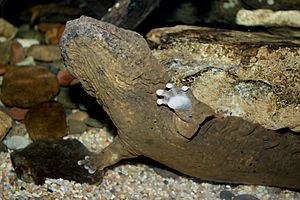
The Eastern Hellbender
One rare and endangered animal is the Eastern Hellbender. This huge salamander can grow up to 27 inches long! It lives in the southeastern Appalachian part of Ohio. Hellbenders are fully aquatic, meaning they live only in water. They breathe mostly through their skin. This means they need very clean, cool, and fast-flowing streams and rivers to survive. Sadly, their homes are threatened by pollution and changes to their habitat.
Ohio's Wonderful Plants
Ohio has a wide variety of plants, from tall trees to tiny mosses.
Trees: Giants of the Forest
Let's learn about some common trees you might see in Ohio:
- Oak Trees: These trees are very strong and can live for hundreds of years. They have rough bark and grow acorns, which squirrels and deer love. The White Oak (Quercus alba) is Ohio's official state tree.
- Maple Trees: Maple trees are famous for their leaves that turn bright red, orange, and yellow in the fall. We also get maple syrup from them! The Sugar Maple (Acer saccharum) is a common type in Ohio.
- Hickory Trees: Hickory trees have tough wood and tasty nuts. The Shagbark Hickory (Carya ovata) has bark that peels off in long, shaggy strips.
- Beech Trees: Beech trees have smooth, gray bark and oval-shaped leaves. They often grow alongside maple trees. The American Beech (Fagus grandifolia) is a common sight in Ohio's forests.
- Pine Trees: Pine trees are evergreens, meaning they stay green all year. They have needles instead of leaves and grow cones. The Eastern White Pine (Pinus strobus) is a tall and grand pine tree found in Ohio.
Wildflowers: Colorful Beauties
Here are some of Ohio's most beautiful wildflowers:
- Trillium: These delicate flowers have three petals and three leaves. They can be white, pink, or red. The White Trillium (Trillium grandiflorum) is a common and loved wildflower in Ohio.
- Wild Geranium: Wild geraniums have pretty pink or purple flowers with five petals. They grow in woodlands and meadows. The Cranesbill (Geranium maculatum) is another name for this flower.
- Bloodroot: Bloodroot flowers are white with many petals. Their roots have a bright orange-red sap. They bloom early in spring. The Bloodroot (Sanguinaria canadensis) gets its name from its sap color.
- Blue-Eyed Grass: Even though it's called grass, this plant is actually a type of iris! It has small, blue or purple flowers with yellow centers. The Narrowleaf Blue-Eyed Grass (Sisyrinchium angustifolium) is common in Ohio.
- Black-Eyed Susan: These are cheerful flowers with yellow petals and a dark brown center. They bloom in late summer and early fall. The Black-Eyed Susan (Rudbeckia hirta) is a popular wildflower in Ohio.
Grasses and Sedges: The Green Carpet
Grasses and sedges might not be as flashy as flowers, but they are very important. They provide food and shelter for animals, help stop soil from washing away, and add texture to the landscape.
- Big Bluestem: This is a tall grass found in prairies and meadows. It turns a lovely reddish-bronze in the fall. The Big Bluestem (Andropogon gerardii) is a native grass important for prairie ecosystems.
- Indian Grass: Another tall prairie grass, Indian grass has feathery seed heads that turn golden in the fall. The Indian Grass (Sorghastrum nutans) provides homes for wildlife.
- Sedges: Sedges are grass-like plants that often grow in wet areas. They have triangular stems. The Tussock Sedge (Carex stricta) is a common sedge in Ohio wetlands.
Ferns and Mosses: Ancient Greenery
Ferns and mosses are ancient plants that don't have flowers or seeds. They reproduce using tiny spores. They like shady, moist places, like forests and wetlands.
- Christmas Fern: These ferns stay green all year. They have tough, leathery fronds. The Christmas Fern (Polystichum acrostichoides) is common in Ohio woodlands.
- Maidenhair Fern: Maidenhair ferns have delicate, fan-shaped fronds. They grow in moist, shady spots, often near streams. The Maidenhair Fern (Adiantum pedatum) is a beautiful fern.
- Mosses: Mosses are small, green plants that grow in soft carpets on rocks, logs, and soil. They help keep moisture in the ground and provide homes for tiny creatures. Many types of mosses can be found in Ohio.
Ohio's Weather: A Mix of Seasons
Ohio has a humid continental climate. This means it has hot, humid summers and cool to cold winters. Rain and snow are common throughout the year.
- Severe Weather: While not as common as in "Tornado Alley," Ohio can have severe weather, including tornadoes.
- Lake Effect Snow: Areas near Lake Erie often get heavy snowstorms, known as "lake effect snow."

Some plants and animals that usually live in warmer climates can be found in southern Ohio. For example, the blackjack oak tree grows here, which is its northernmost range. You might even see plants like the Southern magnolia and Crape Myrtle growing in yards in southern Ohio, which usually prefer warmer weather.
| Location | Region | July (°F) | July (°C) | January (°F) | January (°C) |
|---|---|---|---|---|---|
| Athens | Appalachian | 85/61 | 29/16 | 40/21 | 4/−6 |
| Cincinnati | Southwest | 86/66 | 30/19 | 39/23 | 3/−5 |
| Cleveland | Northeast | 82/64 | 28/18 | 34/21 | 1/−5 |
| Columbus | Central | 85/65 | 29/18 | 36/22 | 2/−5 |
| Dayton | Miami Valley | 87/67 | 31/19 | 36/22 | 2/−5 |
| Toledo | Northwest | 84/62 | 29/17 | 32/18 | 0/−7 |
| Youngstown | Northeast | 81/60 | 27/15 | 32/19 | 0/−7 |
The hottest temperature ever recorded in Ohio was 113°F (45°C) in 1934. The coldest was -39°F (-39°C) in 1899.
Earthquakes in Ohio
Ohio has had over 200 earthquakes since 1776, though most are too small to feel. The strongest known earthquake in Ohio happened in Anna, Ohio, in 1937. It had a magnitude of 5.4.
Major Cities in Ohio
Ohio has many important cities, with three being the largest: Columbus, Cleveland, and Cincinnati.
- Columbus: This is the state capital and Ohio's largest city. It's known for Ohio State University, one of the biggest universities in the U.S. Many large companies and hospitals are based in Columbus.
- Cleveland: Located in Northeast Ohio on Lake Erie, Cleveland has a rich history as a manufacturing and healthcare center. It's home to the Cleveland Clinic, the Cleveland Museum of Art, and the Rock and Roll Hall of Fame.
- Cincinnati: In Southwest Ohio, Cincinnati is a major business hub. It has important companies like Procter & Gamble and Kroger. It's also home to the Cincinnati Symphony Orchestra.
- Dayton: In the Miami Valley, Dayton is known for its aerospace and defense industries, including Wright-Patterson Air Force Base.
- Toledo: In Northwest Ohio, Toledo is famous for its glass-making industry.
|
Largest cities or towns in Ohio
Source: 2020 U.S. Census |
||
|---|---|---|
| Rank | Name | Pop. |
| 1 | Columbus | 905,748 |
| 2 | Cleveland | 372,624 |
| 3 | Cincinnati | 309,317 |
| 4 | Toledo | 270,871 |
| 5 | Akron | 190,469 |
| 6 | Dayton | 137,644 |
| 7 | Parma | 81,146 |
| 8 | Canton | 70,872 |
| 9 | Lorain | 65,211 |
| 10 | Hamilton | 62,082 |
How Ohio is Governed
Ohio's government is set up like the U.S. federal government, with three main parts:
- Executive Branch: Led by the Governor of Ohio. The governor makes sure state laws are carried out. Other elected officials include the Lieutenant Governor, Secretary of State, Auditor, Treasurer, and Attorney General.
- Legislative Branch: This is the Ohio General Assembly, which makes the laws. It has two parts: the Ohio Senate (33 members) and the Ohio House of Representatives (99 members). For a bill to become a law, both parts must approve it, and the governor must sign it.
- Judicial Branch: This branch interprets the laws. It includes local courts, 12 courts of appeals, and the highest court, the Supreme Court of Ohio. The Supreme Court has seven justices.
Local Government in Ohio
Ohio has several levels of local government to serve its communities:
- Counties: Ohio has 88 counties. Most are run by a three-member board of county commissioners, along with other elected officials like a sheriff and auditor.
- Cities and Villages: These are called municipalities. If a town has 5,000 or more people, it's a city; otherwise, it's a village. They have their own elected mayors and councils and provide services like police and fire departments.
- Townships: These cover all areas of the state. They are governed by three trustees and provide some local services.
- School Districts: Ohio has hundreds of school districts for K-12 education. Each is managed by an elected board of education.
Ohio's People: Demographics and Culture
Ohio's population has grown steadily over the years. In 2020, about 11.8 million people lived here.
Population Growth Over Time
Ohio's population has grown from just over 45,000 people in 1800 to nearly 11.8 million in 2020. While the state's growth has slowed down recently, it remains a large and diverse state.
Ancestry and Languages
Most Ohioans are of European descent, with many having German and Irish backgrounds. Ohio also has large African American populations in its major cities. There are growing Hispanic and Asian communities as well.
English is the main language spoken in Ohio. However, many people also speak Spanish, German, Chinese, Arabic, and French. Ohio has a notable number of people who speak Slavic languages.
Religion in Ohio
Most people in Ohio identify as Christian.
- Christianity: This includes various Protestant groups and Catholics.
- Other Faiths: Smaller groups of people practice Judaism, Hinduism, Islam, and other religions.
- Unaffiliated: About 30% of Ohioans say they are not connected to any specific religion.
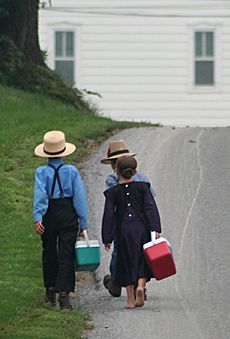
Ohio has the second-largest Amish population in the U.S., after Pennsylvania. The Amish are a group of Christians known for their simple lifestyle and traditional ways.
Ohio's Economy: A Hub of Activity
Ohio has a strong and diverse economy. In 2016, its economy was the seventh-largest among all U.S. states.
- Key Industries: Manufacturing and financial services are Ohio's biggest industries. Ohio has the third-largest manufacturing workforce in the country.
- New Growth: The state is a leader in "green" economy jobs and has a large bioscience sector.
- Major Companies: Many large companies have their headquarters in Ohio, including Procter & Gamble (Cincinnati), Goodyear Tire & Rubber (Akron), and Wendy's (Columbus).
- Ohio Lottery: The state lottery helps fund education, contributing billions of dollars since 1974.

Getting Around Ohio: Transportation
Ohio has a great transportation system, making it easy to travel across the state.
Roads and Highways
- Major Routes: Important highways like I-80/I-90 (Ohio Turnpike), I-70, I-75, I-71, and I-77 cross Ohio. These roads connect many major cities.
- Historic Roads: The Lincoln Highway, the first road across America, passed through Ohio. Today, it's part of U.S. Route 30. The historic National Road (U.S. Route 40) also runs through the state.
Trails for Biking and Hiking
Ohio has many trails for outdoor activities.
- Bicycle Routes: There's a large network of state bicycle routes, often following old railroad lines. The Ohio to Erie Trail connects Cincinnati, Columbus, and Cleveland.
- Hiking Trails: The Buckeye Trail is a long loop that goes around the entire state. Parts of the national North Country Trail and American Discovery Trail also pass through Ohio.
Rail Travel
- Freight Trains: Ohio has a big rail network, mostly used for moving goods.
- Passenger Trains: Amtrak, the national passenger railroad, has three routes through Ohio. You can take a train from Ohio to cities like Chicago, New York, Boston, and Washington, D.C.
- Columbus: Interestingly, Columbus is the largest U.S. city without passenger rail service.

Public Transit
Many Ohio cities have public transportation, mostly bus systems. Cleveland has a rapid transit system with train and bus lines. Cincinnati has a streetcar system called the Cincinnati Bell Connector.
Airports
Ohio has several important airports:
- International Airports: Cleveland Hopkins International Airport, John Glenn Columbus International Airport, and Dayton International Airport are major international airports.
- Military Airfields: Rickenbacker International Airport and Wright Patterson Air Force Base are military airfields. Wright-Patterson is one of the largest Air Force bases in the U.S.
- Cincinnati's Airport: Cincinnati's main airport is actually in Kentucky, just across the border.
Ohio: The "Mother of Presidents"
Ohio is proudly called the "Mother of Presidents" because seven U.S. presidents were born there. This is the second-highest number after Virginia.
- Ohio-Born Presidents: These include Ulysses S. Grant, Rutherford B. Hayes, James A. Garfield, Benjamin Harrison, William McKinley, William Howard Taft, and Warren G. Harding. All seven were Republicans.
- William Henry Harrison: Although born in Virginia, William Henry Harrison lived most of his life in Ohio and is buried there.
Learning in Ohio: Education
Ohio has a strong public education system, from elementary schools to universities.
Colleges and Universities
Ohio is home to many public and private colleges and universities.
- First University: Ohio University, founded in 1804, was the first university in the Northwest Territory.
- Large System: The University System of Ohio is one of the five largest state university systems in the U.S., with over 400,000 students.
- Top Schools: Some Ohio schools, like Case Western Reserve University, Ohio State University, and Miami University, are often ranked among the top research universities in the nation.
- Liberal Arts Colleges: Colleges like Denison University, Kenyon College, and Oberlin College are known for their strong liberal arts programs. Oberlin College was the first college in the U.S. to admit women.

Ohio has:
- 13 state universities
- 24 state university branch campuses
- 46 private colleges and universities
- 6 state-assisted medical schools
- 15 community colleges
- 8 technical colleges
- 24 independent non-profit colleges
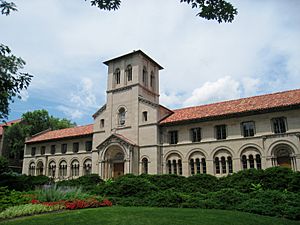
Libraries in Ohio
Ohio is known for having some of the best public libraries in the country. Many of its library systems are ranked very highly.
- OPLIN: The Ohio Public Library Information Network (OPLIN) gives Ohio residents free internet access at their 251 public libraries. It also provides free access to online research databases.
- OhioLINK: This program allows libraries across Ohio, especially colleges and universities, to share materials. This helps students and researchers find books and other resources they might not otherwise have.
Ohio's Creative Side: Arts and Sports
Arts and Culture
Ohio has a vibrant arts scene, especially in music and visual arts.
Music: Rock, Rhythm, and More
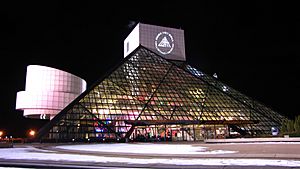
- Rock and Roll Hall of Fame: This famous museum is located in Cleveland. Cleveland disc jockey Alan Freed helped create the term "rock and roll" in the 1950s.
- Rhythm and Blues Music Hall of Fame: Also in Cleveland, this hall celebrates rhythm and blues music.
- Famous Musicians: Many popular musicians are from Ohio, including Dean Martin, Doris Day, John Legend, and Dave Grohl (from the Foo Fighters).
Performing Arts: Orchestras and Theaters
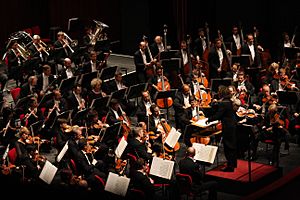
- Playhouse Square: In downtown Cleveland, this is the second-largest performing arts center in the U.S., with ten theaters.
- Cleveland Orchestra: This is one of the top orchestras in the world.
- Other Cities: Many other Ohio cities, like Akron, Cincinnati, and Columbus, have their own symphony orchestras, ballets, and operas.
Visual Arts: Museums and Collections
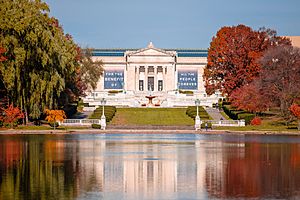
Ohio has 30 art institutions.
- Major Museums: The Columbus Museum of Art, Cincinnati Art Museum, and Cleveland Museum of Art have amazing collections from around the world.
- Unique Collections: The Cincinnati Art Museum has over 100,000 works spanning 6,000 years. The Cleveland Museum of Art is famous for its Asian and Egyptian art. The Billy Ireland Cartoon Library & Museum in Columbus has the largest collection of cartoon art.
- American Art: Youngstown's Butler Institute of American Art was the first museum dedicated only to American art.
Sports in Ohio
Ohio is a big sports state, with many professional and college teams.
Professional Sports Teams
Ohio is home to eight professional sports teams in the major U.S. leagues:
- Baseball: Cincinnati Reds and Cleveland Guardians (Major League Baseball)
- Soccer: Columbus Crew SC and FC Cincinnati (Major League Soccer)
- Basketball: Cleveland Cavaliers (National Basketball Association)
- Football: Cincinnati Bengals and Cleveland Browns (National Football League)
- Hockey: Columbus Blue Jackets (National Hockey League)
Ohio teams have won several championships, including seven World Series titles for the Reds and Indians, two MLS Cups for the Crew, and one NBA Championship for the Cavaliers.
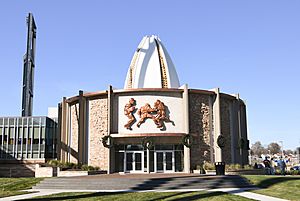
Ohio played a key role in the start of professional baseball and football. The first fully professional baseball team, the Cincinnati Red Stockings, was formed in Ohio in 1869. The NFL was founded in Canton, Ohio in 1920. Canton is now home to the Pro Football Hall of Fame.
College Sports
Ohio loves college sports, especially football!
- Big Ten and Big 12: The Ohio State Buckeyes are in the Big Ten Conference, and the Cincinnati Bearcats are in the Big 12 Conference.
- Ohio State Football: The Ohio State Buckeyes football team is one of the most successful in college football history, with many wins and national championships. They have also had seven Heisman Trophy winners.
- Cincinnati Bearcats: The Bearcats football team made history in 2022 by being the first team from a "Group of Five" conference to make it to the College Football Playoff.
- Mid-American Conference: Six other Ohio teams are in the Mid-American Conference: the Akron Zips, Bowling Green Falcons, Kent State Golden Flashes, Miami RedHawks, Ohio Bobcats, and Toledo Rockets.
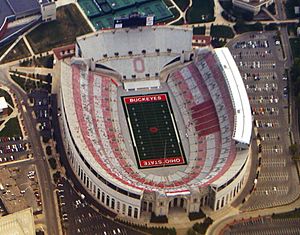
Images for kids
-
The Ohio Country indicating battle sites between American settlers and Indigenous tribes, 1775–1794
-
The route of Morgan's Raid during the American Civil War.
-
Put-in-Bay is located on South Bass Island, one of Ohio's Lake Erie Islands.
See also
 In Spanish: Ohio para niños
In Spanish: Ohio para niños



